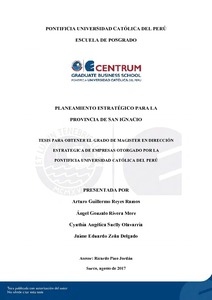| dc.contributor.advisor | Pino Jordán, Ricardo Miguel | |
| dc.contributor.author | Reyes Ramos, Arturo Guillermo | es_ES |
| dc.contributor.author | Rivera Mere, Ángel Gonzalo | es_ES |
| dc.contributor.author | Suclly Olavarria, Cynthia Angélica | es_ES |
| dc.contributor.author | Zeña Delgado, Jaime Eduardo | es_ES |
| dc.date.accessioned | 2017-10-17T23:36:06Z | |
| dc.date.available | 2017-10-17T23:36:06Z | |
| dc.date.created | 2017 | |
| dc.date.issued | 2017-10-17 | |
| dc.identifier.uri | http://hdl.handle.net/20.500.12404/9532 | |
| dc.description.abstract | El presente estudio tiene como objetivo elaborar un plan estratégico que guíe el
camino que debe seguir la provincia de San Ignacio de la región Cajamarca para lograr una
mejoría interna. De esta manera, la provincia podrá generar nuevas actividades económicas y
desarrollar las ya existentes. Para ello, han sido considerados los factores económicos y
sociales de la región, con la finalidad de contar con información apropiada que permita
aprovechar los recursos existentes: humanos, naturales y materiales. Se ha analizado los
factores exógenos y se ha realizado una comparación entre San Ignacio y las otras provincias
que podrían llegar a ser sus competidores directos. El propósito de esto es determinar el
sendero que debe seguirse y establecer los retos que San Ignacio debe enfrentar a fin de
lograr los objetivos que aquí se trazan.
Para la formulación del presente estudio, se ha utilizado el modelo del planeamiento
estratégico, elaborado por D’Alessio (2015). Los resultados demuestran que, si bien San
Ignacio presenta situaciones adversas que durante años le han imposibilitado ser una
provincia preponderante, si los recursos disponibles son utilizados eficientemente y su
población se capacita de forma apropiada, esta provincia podría ser una de las más
competitivas del Perú. Para ello debe desarrollar un proceso estratégico que otorgue mayor
valor agregado a sus fortalezas y oportunidades.
Para concluir, es necesario recalcar que la constante generación de políticas renovadas
en las diferentes regiones del país promueve su competitividad. De esa manera, se
desarrollarán nuevas fuentes de trabajo, así como una mejor condición de vida para la
población, sobre todo para aquella que es más vulnerable: la rural. Asimismo, el desarrollo
económico de toda región deberá estar basado en una visión y misión desafiantes, que
busquen siempre la necesidad de mejorar o, incluso en algunos aspectos, realizar un cambio
impactante | es_ES |
| dc.description.abstract | The objective of this study is to elaborate a strategic plan that will guide the path to be
followed by the Province of San Ignacio, in the Cajamarca region, to achieve internal
improvement. In this way, the province can generate new economic activities and develop
existing ones. In order to do so, the economic and social factors of the region have been
considered with the purpose of having appropriate information that allows taking advantage
of existing resources: human, natural and material. Exogenous factors have been analyzed
and a comparison has been made between San Ignacio and the other provinces that could
become its direct competitors. The purpose of this study is to determine the path to be
followed and to establish the challenges that San Ignacio must face in order to achieve the
objectives outlined here.
For the formulation of the present study, the strategic planning model, developed by
D'Alessio (2015), has been used. The results show that although San Ignacio presents adverse
situations that have prevented it from being a prevailing province for many years, this
province could be one of the most competitive in Peru if the available resources are
efficiently used and its population is appropriately trained. To do this, it must develop a
strategic process that gives greater added value to its strengths and opportunities.
In conclusion, it’s necessary to emphasize that the constant generation of renewed
policies in the different regions of the country promotes their competitiveness. In this way,
new sources of work will be developed, as well as a better living condition for the population,
especially for the one that is most vulnerable: the rural. Likewise, the economic development
of all regions must be based on a challenging vision and mission, always seeking the need to
improve or even in some aspects make a shocking change. This impact should be identified
by population, who will be the main stakeholders for all of this. It’s important to clarify that
population’s position will affect the execution of planned projects | es_ES |
| dc.language.iso | spa | es_ES |
| dc.publisher | Pontificia Universidad Católica del Perú | es_ES |
| dc.rights | info:eu-repo/semantics/openAccess | es_ES |
| dc.rights.uri | http://creativecommons.org/licenses/by-nc-nd/2.5/pe/ | * |
| dc.subject | Planificación regional -- Perú -- Cajamarca | es_ES |
| dc.subject | Desarrollo regional -- Perú -- Cajamarca | es_ES |
| dc.subject | Planificación estratégica | es_ES |
| dc.title | Planeamiento estratégico para la Provincia de San Ignacio | es_ES |
| dc.type | info:eu-repo/semantics/masterThesis | es_ES |
| thesis.degree.name | Maestro en Dirección Estratégica y Liderazgo | es_ES |
| thesis.degree.level | Maestría | es_ES |
| thesis.degree.grantor | Pontificia Universidad Católica del Perú. CENTRUM | es_ES |
| thesis.degree.discipline | Dirección Estratégica y Liderazo | es_ES |
| renati.discipline | 419397 | es_ES |
| renati.level | https://purl.org/pe-repo/renati/level#maestro | es_ES |
| renati.type | https://purl.org/pe-repo/renati/type#tesis | es_ES |
| dc.publisher.country | PE | es_ES |
| dc.subject.ocde | https://purl.org/pe-repo/ocde/ford#5.02.04 | es_ES |






